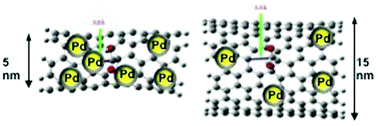Electroless reductions on carbon nanotubes: how critical is the diameter of a nanotube†
Abstract
Detailed experimental and theoretical studies have been performed to investigate the influence of the diameter of multi-walled carboxy-functionalized

* Corresponding authors
a
Controlled Release and Delivery Lab (CRD), Center of Membrane and Porous Materials, King Abdullah University of Science and Technology (KAUST), Thuwal 23955-6900, Kingdom of Saudi Arabia
E-mail:
niveen.khashab@kaust.edu.sa
b Advanced Nanofabrication and Imaging Core Lab, King Abdullah University of Science and Technology (KAUST), Thuwal 23955-6900, Kingdom of Saudi Arabia
Detailed experimental and theoretical studies have been performed to investigate the influence of the diameter of multi-walled carboxy-functionalized

 Please wait while we load your content...
Something went wrong. Try again?
Please wait while we load your content...
Something went wrong. Try again?
Y. Guo, K. Fhayli, S. Li, Y. Yang, A. Mashat and N. M. Khashab, RSC Adv., 2013, 3, 17693 DOI: 10.1039/C3RA42350F
To request permission to reproduce material from this article, please go to the Copyright Clearance Center request page.
If you are an author contributing to an RSC publication, you do not need to request permission provided correct acknowledgement is given.
If you are the author of this article, you do not need to request permission to reproduce figures and diagrams provided correct acknowledgement is given. If you want to reproduce the whole article in a third-party publication (excluding your thesis/dissertation for which permission is not required) please go to the Copyright Clearance Center request page.
Read more about how to correctly acknowledge RSC content.
 Fetching data from CrossRef.
Fetching data from CrossRef.
This may take some time to load.
Loading related content
